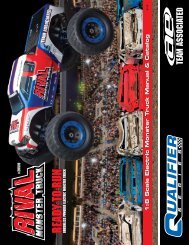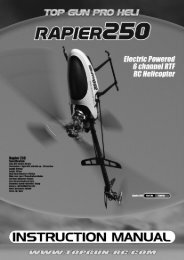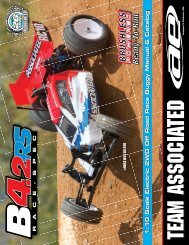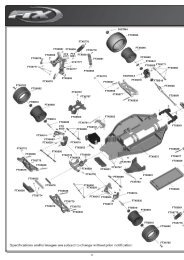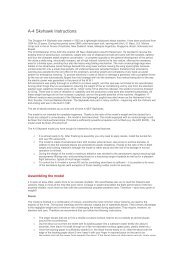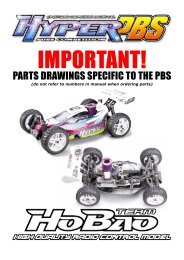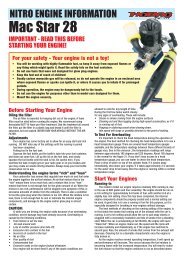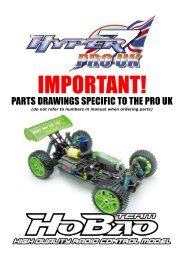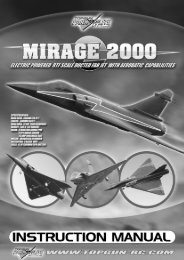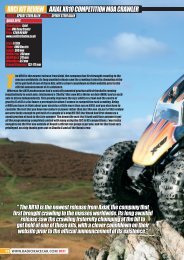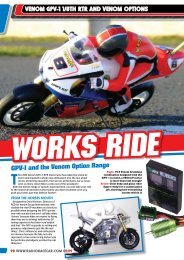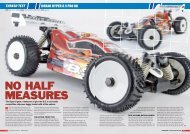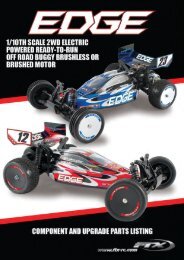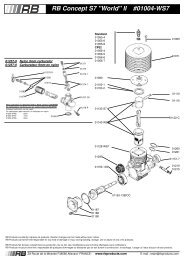Team Associated MGT 4.6 - Manual - Arrow Models
Team Associated MGT 4.6 - Manual - Arrow Models
Team Associated MGT 4.6 - Manual - Arrow Models
You also want an ePaper? Increase the reach of your titles
YUMPU automatically turns print PDFs into web optimized ePapers that Google loves.
2Guidelines for Operation<br />
CAUTION TIPS! Read this before you drive!<br />
• Keep fingers away from all rotating parts while engine is running. Be aware of the rotating driveshafts on the underside of the<br />
truck. Use the handle or bumpers when picking up or turning over the truck.<br />
• Nitro engines get VERY hot. Keep fingers and flammable items away from the exhaust pipe, exhaust header and from the top<br />
of the engine.<br />
• Nitro fuel is poisonous, dangerous and highly flammable! Follow all the directions and heed all the warnings shown on the fuel<br />
container. KEEP FUEL OUT OF THE REACH OF CHILDREN!<br />
• As do all gas engines, nitro engines can emit poisonous gasses. Run your truck ONLY in a well-ventilated area and do not run it<br />
indoors.<br />
• Never drive your truck in a crowded area. Always maintain safe driving distance from spectators and yourself. Always leave a<br />
safety margin around the truck to help prevent collisions.<br />
• Practice good ON 1 ST - OFF LAST transmitter discipline. Always make sure that you turn on your transmitter BEFORE turning on<br />
your truck. Likewise make sure that you turn off your transmitter only AFTER stopping the engine and turning off your truck.<br />
This will help prevent a run-away accident.<br />
• Weak transmitter signals and slow servos cause problems and accidents. Use fresh batteries in BOTH the transmitter and the<br />
receiver. If the red light is flashing on your transmitter or the servos seem sluggish on your truck, it’s time to replace or<br />
recharge (NiCD and NiMH only) your batteries.<br />
• Be aware of transmitter frequencies. Each transmitter and receiver pair comes with a numbered frequency crystal. If you are<br />
driving your truck in an area where other radio controlled vehicles are running, you will need to make sure that you are not on<br />
the same frequency as anyone else. This will help prevent runaway vehicles and glitches; either of which could result in injury<br />
or serious damage to your or someone else’s property.<br />
Tips for Engine Longevity<br />
• Never allow the engine to overheat (260° F, measured at the glow plug; see included .21 AE Engine <strong>Manual</strong> for acceptable<br />
motor temperature ranges).<br />
• Use only approved fuels. Fuels containing more than 20% nitro will run hotter and therefore reduce engine life.<br />
• Do not run engine at full throttle for long periods of time. High engine speeds create more engine heat. Vary the engine speed.<br />
• Do not use lean needle settings. Lean mixture settings will cause the engine to run too hot and decrease its life. Refer to the<br />
engine tuning section for proper adjustment.<br />
• If your truck flips over, do not rev the engine! The engine will run until the tank is empty, even when upside down. Revving the<br />
engine will only cause excess heat in the motor.<br />
• Keep the intake area clean. Clean and re-oil the filter at regular intervals.<br />
• Do not drive the truck in deep or continuous water. If the engine becomes flooded by water, it will most likely need to be<br />
rebuilt.<br />
• Use after run oil before you put the truck away for the day. This will keep the engine lubricated and fight corrosion. After run<br />
oil is available at most hobby shops.<br />
Fuel Selection<br />
• Choose a fuel from a reputable, brand name company that is approved<br />
for car/truck use. Do not use airplane or boat fuels in your truck.<br />
• Choose a fuel that has a nitro content in the range 15%-30%. Lower<br />
nitro percentages will generally result in a cooler engine running<br />
temperature and therefore last longer before needing a rebuild;<br />
cooler-running engines also generally produce less power. 20%<br />
nitro is the most widely used fuel in these engines.<br />
• Fuel color is for identification purpose only and is not important to<br />
performance or durability of your engine.<br />
Oiling the Air Cleaner<br />
When the air filter starts to get dirty, do the following steps:<br />
• Clean the foam with dish soap & water. When it’s clean, remove excess moisture with a towel<br />
& let the filter dry completely before oiling.<br />
• Apply <strong>Associated</strong>’s #7710 Foam Pre-Filter Treatment to help keep the dirt out. Dab a small<br />
amount of treatment all around the filter, put the filter in a plastic sandwich bag, and knead it<br />
until the filter is saturated, but not soaked.<br />
3



